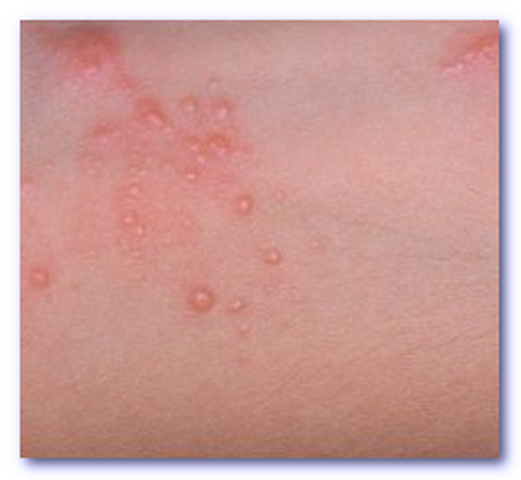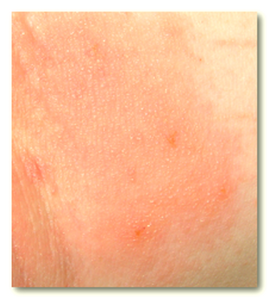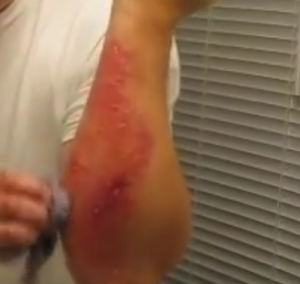Poison sumac rash is caused by an allergy reaction triggered when a person comes in contact with poison sumac plant. Poison sumac is a plant of the same species as poison ivy and poison oak. These plants contain a sap that is oily and irritating. When the sap gets in contact with skin, it results to the itchy rash. The rash may occur just within hours of exposure, but sometimes it may take up to several days before it develops.
The sap released by the plant is called urushiol. A person may be exposed to urushiol or poison sumac sap when they directly come in contact with the plant or when they touch objects or surfaces with the sap. For example, gardening tools, pet’s fur, or camping equipment and clothes that have come into contact with urushiol will make one to develop a rash when he or she touches them.
The urushiol sap is found in all the plant’s part such as the leaves, roots, stems, and even part of the dead plant. Urushiol absorbs easily in skin. When the poison sumac plant is burnt, urushiol could also be inhaled. On top of that, the smoke of a burning sumac plant may expose the skin to chemical within the sap.
The smoke can also expose the chemical to nasal passage, lungs, and throat. When inhaled, urushiol may cause very serious allergic reaction in individuals. This kind of rash is a form of allergy contact dermatitis.
How does the sensitivity to poison sumac sap occur?
The skin itself may not automatically be sensitive to urushiol until the first contact occurs. The sensitivity on skin builds up after and exposure has occurred. When the skin is initially exposed to urushiol, it alerts the body’s immune system of some irritating chemicals.
While at first, it is common to have no visible reaction occurring because already the body has not developed sensitivity to the substance, when a person gets a second or third exposure, the reaction may occur. This is because the body immune system has now prepared a defensive reaction from the first exposure.
Poison sumac grows as a tall shrub or some small tree in swamps or bogs. In each leave of poison sumac, it has about seven to 13 leaflets that are smooth-edged. The leaves are orange in time of spring, but they turn green in summer and in fall, they will transform to yellow, orange or red.
In the month of May, the plant develops yellow greenish flowers and during this time, whitish green fruits may be seen hanging in loose clusters.
What are the symptoms of poison sumac rash?
The symptoms of poison sumac rash are such as itching, red streaks and general redness in areas where the plant rubs or brushes against the skin. A person may develop small bumps and at times, an individual may have larger raised area or hives.
Also, blisters may form and leak fluid. Some individuals may be very allergic to the oil; even with a little bit of the substance, it could cause very serious symptoms that need immediate medical attention such as trouble breathing, widespread large blisters which tend to ooze a lot of fluid, and swelling of face, neck, genitals, and mouth. The eyelids may also swell and shut.
The first time you have the reaction to poison sumac sap; it may take more than a week for the rash to appear. Sometimes, the rash may not occur during the first contact. However, on later contacts, it will tend to develop in one day or two.
You may notice that the rash forms in new areas after some days, though it only occurs in the specific locations or parts where the oil came in contact with the skin. In more severe cases, the rash may take about 6 weeks but typically, it takes about 10 days to 3 weeks to subside and disappear.
Diagnosing poison sumac rash
A doctor will look at the rash and ask questions. The doctor may ask when you were exposed, and how long it took the rash to develop. The doctor may want to know if you have had other rashes, and whether you involved yourself in outdoor activities such as camping, farming, gardening, picnic, or visited areas where you could have exposed yourself to the plant.
Treatment of poison sumac rash
When you get a mild rash from exposure to this urushiol oil, you may consider taking care of the allergy reaction at home, unless it is causing severely discomfort. Apply a wet cloth and try to soak the area in some cold water. You may want to use calamine lotion in order to help in relieving itching.
You should not scratch the itching skin because it could expose it and result in bacterial infection. When you have a rash from poison sumac plant, you should not use medicines such as antihistamines applied on skin, topical anesthetics containing benzocaine, or topical antibiotics containing neomycin.
In case the rash covers a large area, consider seeing a doctor. When the symptoms are severe, you may also want to see a doctor. A person with a severe rash may be administered corticosteroid pills and shots.
Poison Sumac Rash Pictures



